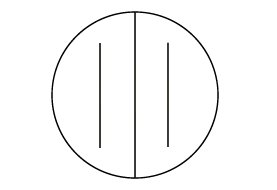8.3: Protein Hydrolysis w. Procedures and Results
- Page ID
- 123379
Proteins are made up of various amino acids linked together in long chains by means of peptide bonds. Many bacteria can hydrolyze a variety of proteins into peptides (short chains of amino acids) and eventually into individual amino acids. They can then use these amino acids to synthesize their own proteins and other cellular molecules or to obtain energy. The hydrolysis of protein is termed proteolysis and the enzyme involved is called a protease. In this exercise we will test for bacterial hydrolysis of the protein casein, the protein that gives milk its white, opaque appearance.
Skim Milk agar (one plate) See Fig. .
ORGANISMS
Trypticase Soy broth cultures of Bacillus subtilis and Escherichia coli.
PROCEDURE (to be done in pairs)
1. Divide the Skim Milk agar plate in half and inoculate one half with Bacillus subtilis and the other half with Escherichia coli as done above with the above starch agar plate (see Fig. ).
2. Incubate upside down and stacked in the petri plate holder on the shelf of the 37°C incubator corresponding to your lab section until the next lab period. If casein is hydrolyzed, there will be a clear zone around the bacterial growth (see Fig ). If casein is not hydrolyzed, the agar will remain white and opaque (see Fig. )).
|
Fig. : Skim Milk Agar |
Fig. : Inoculation of Skim Milk Agar |
Fig. : Casein Hydrolysis by Bacillus subtilis on Skim Milk Agar |
Fig. : No Casein Hydrolysis by Escherichia coli on Skim Milk Agar |
|---|---|---|---|
 |
|||
| Skim milk agar before inoculation. | The clear zone around the growth of the Bacillus subtilis on the right no longer contains casein. The casein was hydrolized by a protease produced by the bacterium | The casein was not hydrolized by the Escherichia coli on the left. The agar remains white and opaque. | |
| (Copyright; Gary E. Kaiser, Ph.D. The Community College of Baltimore County, Catonsville Campus CC-BY-3.0) | |||
Results
The protein casein exists as a colloidal suspension in milk and gives milk its characteristic white, opaque appearance. If the casein in the milk is hydrolyzed into peptides and amino acids, it will lose its opaqueness.
- If the bacterium produced an exoenzyme capable of hydrolyzing the casein, there will be a clear zone around the bacterial growth (see Fig. 6A).
- If the bacterium lacks the exoenzyme to break down casein, the Skim Milk agar will remain white and opaque (see Fig. 6B).
Record your results and indicate which organism was capable of hydrolyzing casein (+ = hydrolysis; - = no hydrolysis).

| Escherichia coli | Bacillus subtilis |
| Casein hydrolysis = | Casein hydrolysis = |
Contributors and Attributions
Dr. Gary Kaiser (COMMUNITY COLLEGE OF BALTIMORE COUNTY, CATONSVILLE CAMPUS)

